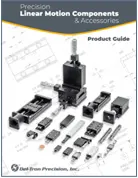Ball Slide Positioner Reduces Setup Time on Centerless Grinders for Medical Guidewires from 10 Minutes to 15 Seconds
Royal Master Grinders, Inc., Oakland, New Jersey
The use of micrometer-driven ball slide positioners has reduced setup time for centerless grinder guide systems from 10 minutes to 15 seconds, speeding production of guidewires used in medical procedures. The tips of these wires, which travel through blood vessels in procedures such as angioplasty, must be ground to a unique profile and a smooth surface finish over their entire profile of anywhere from 12" to 36". Royal Master centerless grinders employ a patented technique to track the end of the guidewire so the regulating wheel moves precisely at a preprogrammed position. This will generate various shaped and tapers into the wire. Micrometer-driven ball slide positioners are used in Royal Master's centerless grinders to position the wire between the grinding wheels, giving perfect alignment with the wheels and keeping the wire from moving or bending during grinding. Instead of a process of trial and error to position the wire, the operator simply dials in the desired location and the positioner travels to the precise spot.
Royal Master Grinders, Inc. manufactures a wide variety of centerless grinders to meet the needs of a diverse range of applications. More than 35% of the company's business comes from the medical industry while the remainder of its market is found in a diverse range of industries including automotive, cutting tool, dental, oil, screw machine, musical, and nuclear. Thousands of Royal Master grinders around the world produce guidewires, catheters, automatic components, punches, carbide, and much more. Established in 1946, Royal Master has grown under the principle of building a high-quality, compact centerless grinder at competitive prices.
Better Process
Centerless grinding is a technique used to shape round and oblong objects, such as the medical guidewires used in angioplasty. During this procedure, after a local anesthetic is injected into the groin or shoulder area, a physician inserts a hollow flexible tube called a guidewire or guide catheter into an arm or leg artery. A monitor displays an x-ray image of the wire as it travels through the body toward the coronary artery. Radiopaque dye may be delivered to the area to help the physician see the exact location of the blockage. A smaller catheter is then inserted into the guide wire. This one has a balloon at its tip. When the tip reaches the obstruction, the balloon is inflated to widen the obstructed artery. After the balloon catheter is removed, more x-rays are taken to see if blood flow has improved. The procedure usually takes between 30 and 90 minutes. It may also be used to treat blockages in other arteries.
Centerless grinding is the preferred method of producing medical guidewires, because it maintains consistency in material qualities. The material is ground away rather than moved or compressed with heat. Grinding is done by two wheels, a grinding and a regulating wheel. In between the wheels is a support blade, which the part rests. The position in relation to each other changes as the profile of part changes. In some situations, the wheels may be positioned as little as 0.0014 inch apart. The grinding machine must accurately load the part and guide it between the wheels. With small parts such as medical guidewires, and guiding the wire into the correct position between the wheels plays an important role in achieving the desired level of accuracy, and surface quality. When the wire is positioned improperly, the wire will not attain a deviation of less than .000050" on the diameter. In the case of medical guidewires, centerless grinders are used to produce the finely tapered tips of these devices. Starting with stainless steel wire with a 0.008 inch to 0.30 inch diameter, the taper is generated in multiple stages. Starting at the tip of the wire, the grinder cuts the wire to a diameter of 0.002 inch, for example. Moving up the wire, the grinder then cuts it to a 0.006 inch diameter, and then further up, to 0.008 inch. This taper, which is usually coated in Teflon, can be up to 36 inches long, and have an infinate amount of shapes, and profiles.
Boosting efficiency and accuracy
Sixteen years ago, Royal Master developed a more efficient way of creating different stages of the taper. Known as progressive sizing, the machine generates different diameters by adjusting the space between the grinding wheels and the wire as the wire moves through the machine. In spite of this significant improvement to the process, however, there were still a number of other improvements that Royal Master wanted to add to its newest grinding machine, the Generation 5. For example older machines required certain manual operations that slowed the grinding process and introduced the possibility of error. Royal Master engineers wanted to automate these functions in the Generation 5 machine.
One such process was adjusting the guide that positioned the wire in relation to the grinding wheels. After eyeballing the wire to determine the correct position, the operator turned a screw to adjust the position of the guide. This trial-and-error process usually took about 10 minutes. It was required at the start of each new grinding operation and also each time the surface of the wheel was altered. For example, if the surface of the wheel was dressed off 0.002 inch, the guide would have to be moved by that distance as well.
Automating guide adjustment
In the Generation 5 machine, Royal Master replaced the manually adjusted wire guide with a Del-Tron ball slide positioning stage. This device incorporates a spring-loaded micrometer drive that allows precise repeatable adjustments with low friction and zero backlash. The positioner provides accuracy to 0.0005 inch of travel and repeatability of 0.0001 inch. It also features a positive locking capability consisting of a steel shim and extended micrometer bracket secured by a screw mounted to the side of the stage carriage. This allows the user to positively lock the position of the carriage during use. Locking micrometer heads are also available to lock the micrometer setting. Del-Tron makes more than 60 models of the ball slide positioner with load capacities of up to 60 pounds
Royal Master engineers chose the model 101X, which is a single-axis positioner, for the wire guide. Now, instead of having to eyeball wire position and turn an adjustment screw, the operator simply enters the desired position on the computer screen. The Del-Tron positioner automatically moves the guide to that exact location. In addition to being much more accurate than the manual approach, this way is much faster, requiring 15 seconds at most. By coincidence, Del-Tron uses Royal Master grinders to finish the 8 shafts used in the 101X stage.
The Generation 5 features a Hi-Accuracy CNC system with antifriction ways, a stepping motor with encoder, and a zero backlash roll screw design to deliver repeatable performance to better than ± .001mm. It also incorporates a user-friendly windows interface that has easily identifiable controls on a 17-inch screen. The operator enters profile parameters either in metric or imperial units into a Taper Specifications screen.
Another important advance in this machine is a laser gage that makes the grinder a closed-loop system. After downloading wire profile parameters from the grinder to the laser gage over a peer-to-peer network, the user can gage the wire. It is placed in a clamping trough. The user presses GAGE WIRE button and then sees the profile, with tolerances indicated, drawn on the computer screen. A zoom feature permits a closer look at portions of the wire. A Del-Tron 101X positioner is also part of the laser gage. The device positions parts accurately within the clamping trough.
Del-Tron Precision began operations in 1974 supplying original equipment manufacturers with the world’s first commercially available subminiature ball slide. Since then, thousands of Del-Tron ball slides have been incorporated into medical analyzing and testing machines, semiconductor processing equipment, computer peripherals, assembly systems, scientific instruments and many other machines. Del-Tron’s modern corporate campus boasts highly automated computer controlled equipment and final inspection of 100% of all products has been Del-Tron’s policy since its inception. For more information, contact Del-Tron by phone at 800-245-5013, by fax at 203-778-2721 or by email: deltron@deltron.com.

